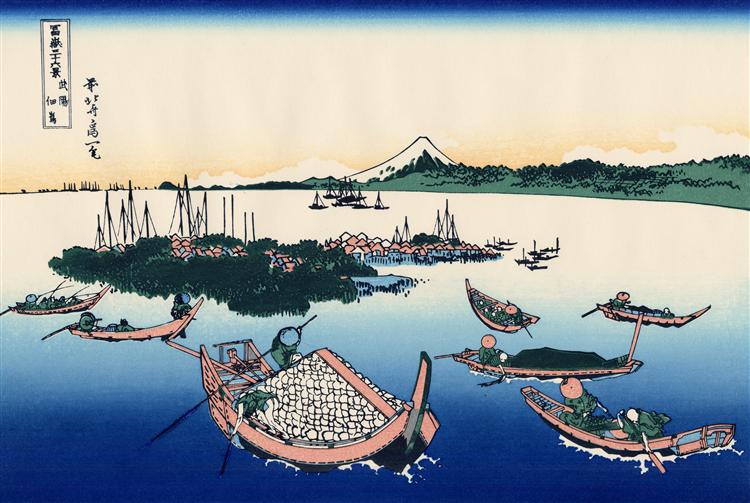Описание
Katsushika Hokusai's Tsukada Island In The Musashi Province sublimely encapsulates the Japanese ukiyo-e master's ability to combine the depiction of nature with everyday life, themes that permeate his vast output. Painted in the 19th century, this work falls within the tradition of Japanese landscapes that explore both the beauty and spirituality of the natural environment.
Looking at the painting, it is evident that Hokusai employs a carefully balanced composition. The image features an island in the center of the canvas, surrounded by waters that evoke a sense of calm and serenity. The island, rendered in a stylized manner, mixes iconographic elements of the Japanese landscape with particular attention to detail. The shape of the island is curvilinear, suggesting a dialogue between sky and water, both fundamental elements that frame the natural setting.
The use of colour is remarkable and reflects Hokusai's mastery in the application of the woodcut technique. Shades of blue and green predominate, creating an enveloping atmosphere that transports the viewer to this serene environment. While the blue of the water contrasts with the green of the vegetation that covers the island, a harmonious palette is observed that invites contemplation. Hokusai uses subtle gradations that create depth, providing a sense of three-dimensionality in a work that, at first glance, appears flat.
Elements of everyday life can be distinguished in the work, especially in those details that represent human activity. However, Hokusai seems to choose to represent these elements in an almost ethereal way, suggesting a harmonious coexistence between men and nature. The figure of a boat on the water is one of the few direct representations of human activity, which reinforces the main theme of the painting: the intricate relationship between humans and their natural environment.
Furthermore, Hokusai, in his unmistakable style, presents a background in which evanescent clouds play with the light, adding a poetic dynamic to the image. This phenomenon is characteristic of ukiyo-e, where the sky often becomes a key player within the visual narrative, symbolizing the connection between the celestial and the earthly.
It is interesting to note that the work can be considered in the broader context of the series Thirty-six Views of Mount Fuji, which also includes landscapes that reflect humanity's interactions with the natural environment. Although this painting does not directly include Mount Fuji, the spirit of that series is present in the sense of an invitation to meditate on the beauty of the Japanese landscape and the respect for nature that Hokusai so masterfully captures.
Katsushika Hokusai, recognized as one of the great masters of ukiyo-e, left a legacy that goes beyond his individual works. His ability to fuse aesthetics with emotion, as well as his deep appreciation for natural beauty, are manifest in "Tsukada Island in Musashi Province." This work is not only a testament to his technical skill, but also a reflection of the spirit of his times, where each stroke and color dialogue to summon a unique experience, inviting the viewer to enter into the peace and wonder of a landscape that, although specific, speaks to a universal truth about the relationship between humans and the earth.
KUADROS ©, a famous painting on your wall.
Hand-made oil painting reproductions, with the quality of professional artists and the distinctive seal of KUADROS ©.
Painting reproduction service with satisfaction guarantee. If you are not completely satisfied with the replica of your painting, we will refund 100% of your money.

